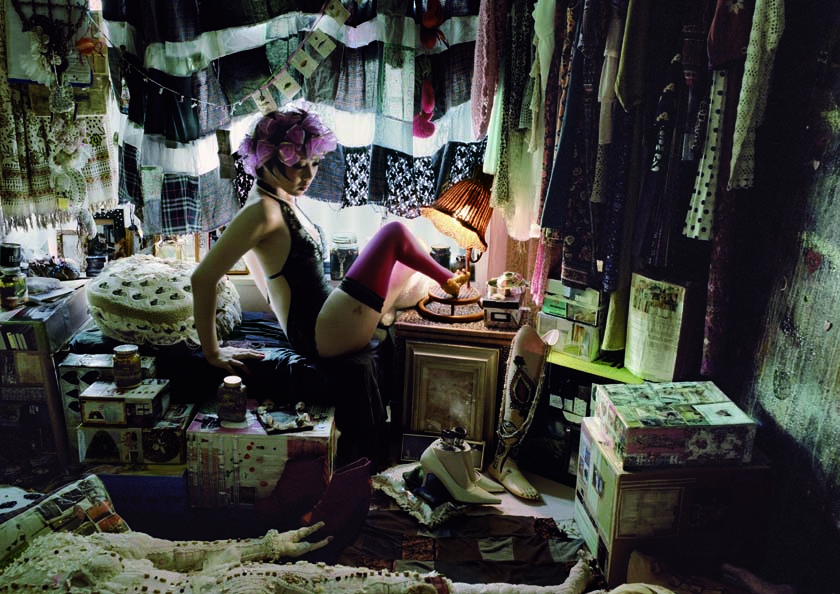Mari Katayama “bystander #016” (2016), Self-Portrait
Mari Katayama is a Japanese artist from central Japan. She has loved sewing and creating objects since she was a little girl. This skill helped her to find her creative side and was invaluable to her after having both of her legs amputated and she needed to start creating clothes to fit her artificial legs. She has since expanded to other artistic endeavors including developing high heels for her artificial legs, holding photo exhibits, and singing!
Mari was kind enough to take a few minutes from her busy schedule to answer a few questions. After reading the interview, please be sure to check out her website and social media!
Hi Mari! We saw an article about you and are super-excited you agreed to this interview! First of all, where are you from?
I was born in Saitama pref. and grew up in Gunma Pref. Japan. I spent my life in Gunma until I went to Tochigi to study at Tokyo University of the Arts. It is located almost the very center of Honshu islands of Japan, and is very mountainous. Where I lived was in the plains but you see the mountain ridge lines all around. There are also many rivers flowing down, and these views and memories lead me to create my self-portrait series “on the way home” (2016).
What is your disability and how does it affect you?
I am born with tibial hemimelia, a deficiency in which the major, larger leg bone is absent. My legs were amputated at the age of 9.


Mari Katayama “shadow puppet #01402” (2016), Self-Portrait
What was it like having a disability growing up? Did you have any challenges?
As a child, I wore special shoes buckled to my legs with braces, which meant I couldn’t wear regular clothes. My grandmother and mother were constantly sewing clothes for me, and I learned to hold a needle and thread before I could hold a pencil. Sewing became second nature for me, and that became the basis of my creation of objet-d’arts.
Inevitably, my disability set me apart at school. The bullying started in third year and it got so bad I began to skip school and, for a while, was even kept away [from school] by my parents. I decided to have my lower legs amputated because it was a choice between being bound to a wheelchair for the rest of my life – or being able to walk but losing my legs. I chose to walk.
However, although these episodes may be considered “hardships” or “challenges” rather tougher compared to “normal” people, I myself don’t consider it was “tougher,” people have their own challenges and the weights cannot be compared.
Please refer to the interviews below.
https://www.theguardian.com/artanddesign/2017/mar/06/mari-katayama-japanese-artist-disabilities-interview
http://www.fragmentsmag.com/en/2012/06/interview-katayama-mari/
http://www.fragmentsmag.com/en/2015/03/mari-katayama-youre-mine/
You are an up and coming artist with many exhibits under your belt already. How did you get interested in art?
At first, I didn’t intend to be an artist, or never thought my works could be art.
I grew up in a family where sewing was very common. My mother and grandmother always made my clothes. I couldn’t wear normal clothes with my special shoes buckled to my legs with braces.
And that environment led me to make objet-d’arts myself. It was a hobby at first .
I started taking pictures of the works I sewed. And that “eventually” opened my way to art.


Mari Katayama “Shell” (2016), Self-Portrait
Fashion plays a big part in your work. Can you tell us a bit about your interest in fashion, challenges you have had, and your high heels exhibit?
For detailed stories on fashion and my high-heel project, please refer to the interview below.
http://www.fragmentsmag.com/en/2012/06/interview-katayama-mari/
Do you have a message for people with disabilities regarding fashion and self-expression?
Not only with fashion, but first of all, please find what fascinates you from heart. And work hard to make it yours. Even if you tried hard and it didn’t come to you, ask for help. There will be a way!
What are your plans for future work and exhibits?
I am going to give birth this July, and I am planning to take a bit of a break for while. But I know this experience will inspire me and lead me to new style and ideas. I hope you to keep an eye on me!
Are you involved in any other performance arts?
I sing, model and act.
Especially, I love to sing and often do events with singing.
We mainly focus on accessible travel, so for a foreign visitor to Japan, can you tell us your favorite (wheelchair accessible!) art gallery/exhibit space? Do you have any permanent exhibits?
Currently I don’t have permanent exhibitions. Until July 17th 2017, My works will be exhibited as a part of opening exhibition of Ota City Museum and Library.
http://www.artmuseumlibraryota.jp/post_artmuseum/602.html
(Sorry! The English page is under construction.)
I found The National Art Center, Tokyo located in Roppongi has great accessibility.
http://www.nact.jp/english/
(Editors note: We agree! See our review.)
Sadly, I can’t come up with other galleries that are accessible.


Mari Katayama “I’m wearing little high heels” (2011), Self-Portrait
We want the world to know about you and your work. How can people see your work and follow you online? Do you have a website, Instagram or Twitter account.. etc?
Website: http://shell-kashime.com/
Faceboook : https://www.facebook.com/marikatayama777/
Instagram: https://www.instagram.com/katayamari/


Mari Katayama “You’re Mine #001” (2014), Self-Portrait




Responses